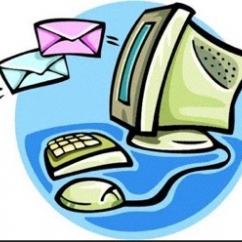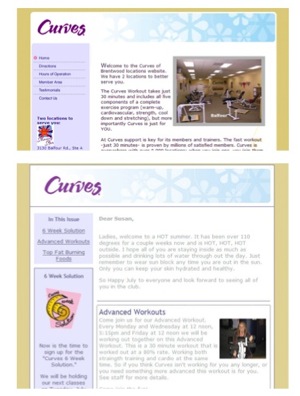Articles and News
10 EASY, DO-IT-NOW TIPS FOR BETTER EMAIL MARKETING | February 20, 2013 (0 comments)

Scottsdale, AZ—American consumers are exposed to approximately 6,500 marketing impressions per day. No, that’s not a misprint—that’s a lot of messaging.
But not only can a single-store luxury jeweler stand out, a small business has far more advantage than the big guys when it comes to successful email marketing, says Ron Cates, director of new market development for Constant Contact, a leading email marketing service. Cates was one of the presenters for the new Retailer Workshops at the Centurion Show earlier this month, and later he gave an exclusive interview to The Centurion Newsletter.
“There’s been a lot of talk [among digital marketing pundits] that email is dead,” he told The Centurion. “Email is not dead. 95% of people in the United States do email, and most on a daily basis,” he emphasized. Furthermore, consumers are far more tolerant of receiving commercial messages via email than they are via social media, and a recent survey shows email is most consumers’ preferred way of receiving marketing messages.
“Email is how you monetize social. If all you do is promote yourself on Twitter, we won’t follow you. But we will accept some email promoting you or your business.”

Ron Cates of Constant Contact makes a point during his retailer seminar at Centurion Scottsdale 2013.
The accent is on “some,” he stressed. “Don’t do a lot of ‘buy my stuff’ email. I know you’re selling stuff, I want to know why you’re different and why I should have a relationship with you.”
The key word is “relationship,” he said. According to the Harvard Business Review, consumers will spend 69% more with a vendor if they perceive a relationship there. Cates used the example of a local menswear shop where he buys all his clothes. They know him, know his tastes, know his size, greet him by name when he comes in, and so forth. They’re not the low-price leader when it comes to men’s clothes, but he’d rather shop there and get the service and expertise than go to a cheaper store where he doesn’t.
“We all have a place like that,” he says.
But do make sure all your emails include social media “follow” buttons to allow your audience to pick the channel they most prefer receiving your communications. Cates shared some more best practices for successful email marketing:
1) Don’t make your entire email an image! Many email programs will block images, so there needs to be enough text that the email still makes sense without the images. When you’re creating the email, put enough text behind the images in each block; i.e., where it says “header block” in the template, put your name, don’t leave the “header block” text because if your logo doesn’t show up in the user’s inbox, you want your name to show up.
2) Usability is more important than design. People read a computer screen 30% to 40% slower than print. Make sure it’s clear and easy to read, with a sans-serif font like Arial or Tahoma, rather than a curlicue or serif font. Black letters on white background is easiest to read; save colors for headlines or short calls to action, not text.
3) Make it easy to opt out. The Federal CAN-SPAM act requires all email marketing have a way to opt-out, and any requests to unsubscribe are supposed to be taken care of within 10 days. But apart from that, make it easy for users to unsubscribe; don’t make them go hunting for the place to click on it.
4) 60% of the decision to open an email is based on the “from” line. The most important step you can take here is to make your “from” line reflect a real person; i.e. yourname@luxuryjewelers.com; not news@luxuryjewelers.com or info@luxuryjewelers.com.
5) 30% of the decision to open an email is based on the subject line. The most important element of the subject line is to keep it short—no more than 40 characters, including spaces. With so many people using mobile devices, brevity is essential, says Cates. According to Constant Contact’s research, the subject lines that get opened the most are those that tell exactly what’s in the email.
6) Open rates fluctuate by time of day and day of week—but there’s no set-in-stone rule about what’s best. Currently, midweek (Tuesday, Wednesday, Thursday) are the best days, but that’s changing as people read email seven days a week, says Cates. Early morning is best for open rates; but later may be better for action rates—someone finished his or her emails by 9 a.m., so one that comes in at 10:30 means they have time to do something about it. That said, if you’re running a special weekend sale, Friday afternoon might be a better time to send the email.
7) Emails don’t have to be opened to generate action! Counterintuitive as it seems, 31% of the time consumers will come in and buy even if they didn’t open the email. Especially if your subject line says something like “Sale this Weekend,” people don’t need to open the email to take action on it.
8) All these tips are fairly universal, regardless of business type. But for a luxury business, the “secret sauce” is in list segmenting.
“You can’t have 10 different TV commercials and blast each only into the homes of a few individuals, but you can do that with email. You can have endless lists, and it makes it much easier to target the right audience,” says Cates. For example, you may have a list of watch collectors, another of recently married couples, and so forth, and you target each email to the right audience instead of sending everything to everyone.
“This is where a small business is far more nimble than a large corporation,” he said. Even some large luxury firms have been unable to successfully segment the way an independent retailer can.
9) Luxury jewelers need to build their own lists, and always be working on those lists, emphasized Cates. Buying a list is almost always going to cost more than you get in returns. Take every opportunity and point of contact to get your customers’ email addresses and ask if you can send them your newsletter.
10) Use an email marketing service. “Obviously, I think Constant Contact is the best one, but even if you don’t use us, use a service. Don’t do it yourself from Outlook. Consumers expect a sophisticated HTML presentation, not all text,” he said. Most services, including Constant Contact, have hundreds of templates to choose from and personalize.
“Make sure your colors, logo, etc., are consistent. The structure of your emails can change, but the branding shouldn’t,” Cates said.

This web page (top) and email newsletter (bottom) from Curves, the women's health club chain, was one of the examples Cates used to illustrate his point about branding continuity between web and email.







